Talismans of luck and their lineage
Most people are probably at least once in their life so used talismans for luck, whether it be a coin, a horseshoe, or anything else. There is no scientific evidence that it actually works, but many people believe in their strength.
Horseshoes 10.

The first horseshoe ever discovered were the Etruscans in 400 BC. e. When this superstition first appeared in Northern Europe (most likely, nomadic Celtic tribes), horseshoe hung over the entrance to the room to ward off evil elves wandering in the forest.
Horseshoe made of iron, which was believed to bring good luck, too. (Rumor had it that the elves are afraid of weapons of their enemies, which is made of iron.)
Horseshoe, was said to resemble a crescent symbol of the Celtic god of the moon. Depending on the sources, the use of horseshoes as a talisman for good luck is variously described. Somewhere horseshoe hung the two ends of the up - to collect good luck in the cup, while the horseshoe hanging two ends pointing down, it was thought, "poured" their entire fortune on those who pass under them.
According to another traditional point of view, it was believed that in order to attract good luck horseshoe must be kept on seven iron nails because the number 7, as you will learn later, is often considered very powerful.
9. Knock on wood

The tradition of knocking on wood is not any clearly origin. Most likely, this is because the ancient pagans had a lot of spirits, which is considered the home of the forest and the sound of the tree can be seen as protection against evil or a request to the deity of favor.
Perhaps something like the ancient pagans did, trying to make some more noise when drive away evil spirits or tried to prevent them from hearing (then hurt) on someone else's good fortune. Tradition knock on wood came to the XIX century, but gained real popularity due to many games in which children were playing (for example, the game of hide and seek). By the XX century superstition it became as widespread, what is now.
8. Number 7
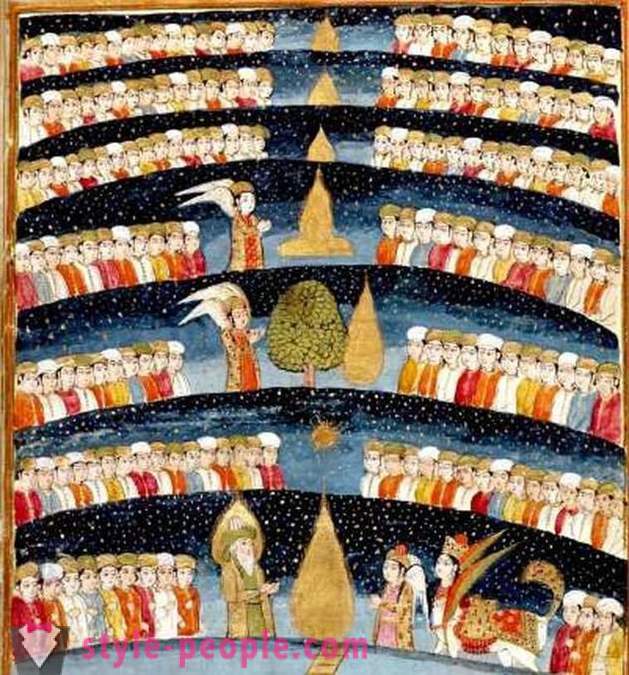
There is a lot of numbers considered lucky, but the most powerful of them - the number 7 is considered lucky because of its connection with almost every religion, the number 7 is especially valuable for the Jews (where the practice is most likely, and there) and Christians because it is considered a sacred number (7 days of creation of the universe, seven virtues, and so on. d.).
This number also has a special place in a number of myths around the world. In ancient Egypt, for example, believed that there are seven ways to heaven. However, in China, the number 7 is considered unlucky because it is associated with death. There, like the number 8, because it rhymes with the word for "prosperity" or "welfare".
7. Fortune Cookie

Many people believe that the cookie-divination are of Chinese origin, as they are very common in Chinese restaurants around the world. It is also believed that they bring good luck in the form of a paper strip with the prediction, hidden inside the cookie.
However, they came up with in 1914, a Japanese named Makoto Hagiwara (Makoto Hagiwara), who lived in San Francisco. (Some people mistakenly believe that it was a Chinese American named David Chung (David Jung), but Hagiwara cookies were created first.)
Cookies themselves are likely to come from the Japanese crackers with predictions, known as "tsujiura senbei". These rice cakes stuffed with paper fed to the predictions of Japanese temples in the XIX century. As to how they appeared in Chinese restaurants, many Japanese immigrants who lived in California in the XX century, were the owners of catering establishments in which supplied Americanized Chinese food, as traditional Chinese dishes, it seems, were not popular.
6. The Gris-Gris
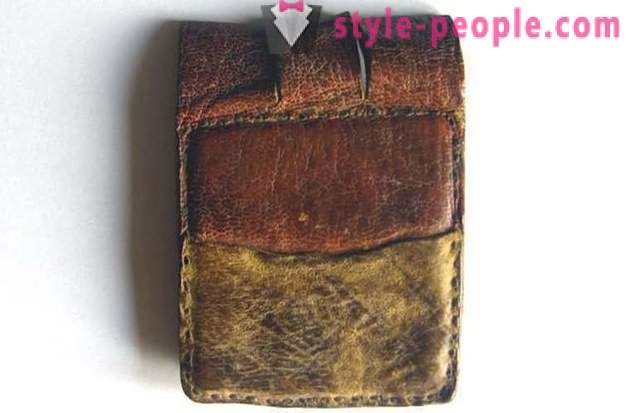
The main element of the West African voodoo religion and traditional religion of voodoo in North and South America, gris-gris - a pouch for good luck with some interesting features. Men traditionally wear it around your neck, and the women are either attached to the bra or blouse to the inside. Basically it is worn for good luck, but it can protect and evil. In some West African countries gris-gris is considered an effective method of birth control.
The first to use it were Malians, who wrote on it Islamic verses shortly before or immediately after the steel in contact with Muslim missionaries began to spread his new religion. Depending on what is inside the bag, gris-gris can be used as a form of black magic. Common ingredients that are placed in the gris-gris, are herbs with alleged magical qualities and parts of dead animals.
5. Jin Chan (Jin Chan)
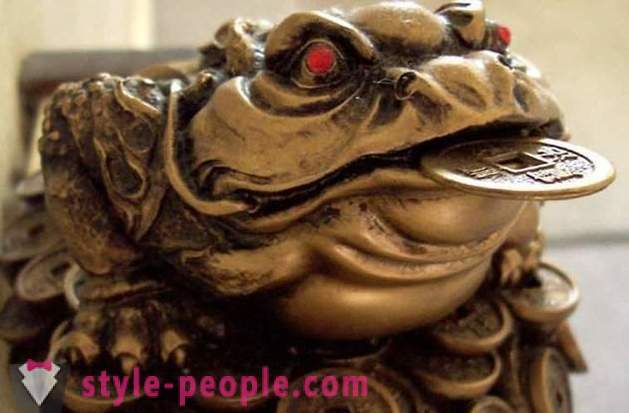
Known as the "Money Frog", Jin Chan, or Chan Chu (Ch'an Chu) - it threelegged bullfrog with red eyes, usually sitting on a pile of coins. Introduced in China thousands of years ago, Jin Chan is a common mascot in Chinese culture, especially in Feng Shui, but its use as an amulet on wealth evolved much later - perhaps in the XVI and XVII century. However, this may be related to the ancient myth of the Moon frog, which has become the essence of the moon.
They say it brings good luck, mainly in the form of cash income and cash frog figurines are usually made with coins in his mouth. (If the frog is not a coin in the mouth, then it should be sent away from home, otherwise it will suck the money from him.)
4. Maneki-Neko (Maneki-Neko)
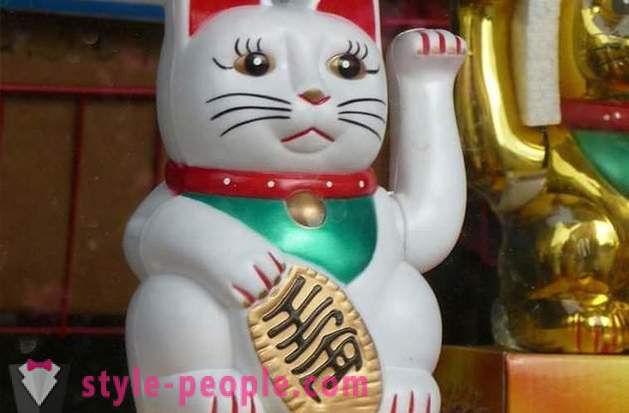
In Japanese, "Inviting Cat" or "beckoning cat" Maneki-Neko - a Japanese talisman for good luck in the form of a cat with a raised paw. Emerged in Japan somewhere between the XVI and XVIII century, Maneki-Neko is usually placed inside the windows or in shop windows, because, they say, it brings prosperity to businesses. Many of them are also represented with coins in the legs.
At the heart of the classic mythical origin of Maneki-Neko is the story of a depressed businessman, met terribly hungry cat. Despite the fact that the man had no money, he nourished cat, straightening his health, and his business began to flourish as soon as the cat began to sit in front of his store, attracting passers-by.
There are several superstitions regarding elements figurines. For example, if a person wants to lure the happiness of a cat left foot should be raised, and if its purpose is to health, the right to be raised.
3. Kachina dolls (Kachina Dolls)

Used residents Hopi in North America, Kachina dolls appeared around the end of the XVIII century. They symbolize one of the hundreds of spirits that are said to interact with the tribe. Traditionally carved out of poplar roots, these mascots are often decorated, depending on their destination, necklaces, bracelets and even knives.
Hopi girls start giving-Kachina dolls from one years old, and give two dolls each year. In addition to the fact that the Kachina dolls carry an educational element for young girls, teaching them their culture, they are also said to bring good luck to those families who make them, protecting against disease and distress.
2. Carranque (Carranca)
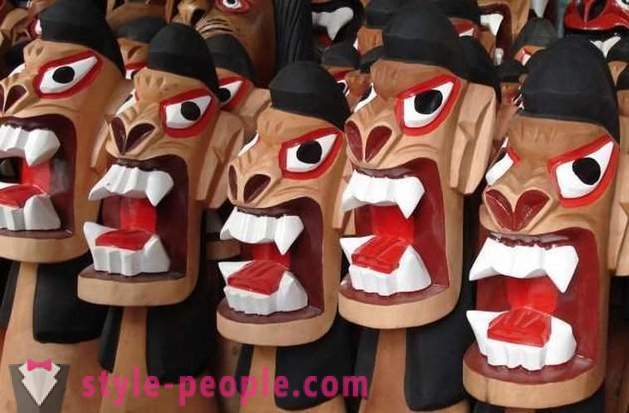
In a translation from Portuguese meaning "gloomy, sullen face," Carranque - a statue, usually carved from wood, which is located at the front of the boat. Its main function is to protect the boat from the evil spirits that may try to get on it or turn. According to legend, Carranque also published a low moan to warn the crew of the approaching danger. Came from the San Francisco River basin in Brazil, Carranque statues were first used in the second half of the XVIII century. Although not so widely used today, except for sale to tourists, they are usually depicted with terrifying faces, which are considered to be, deter river creatures.
1. Palade Khik (Palad Khik)
most strange in this list, Palade Khik - Thai amulet is used to attract good luck. As he translated as "honorable penis substitute", it becomes clear what kind of shape it has.
Originally created by the Indians, they were introduced to Thailand by monks in the VIII century and became popular in its current use. In fact, the earliest examples of this amulet is the embodiment of the Hindu god Shiva.
Palade Khik, said to bring virtually any desired benefit, but mostly it protects the sexual organs of any trouble. Amulets can be of different sizes, and some of them may even reach several meters in length.













































